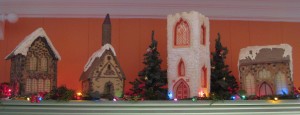For several years it appeared that our gingerbread structures were none the worse for wear despite constant exposure to household elements. When I started to notice a few small flying moths, I searched the pantry, found nothing, and tried to ignore the problem. But the moths became more difficult to ignore. I began to spot them regularly in the vicinity of the playroom hutch, and I was soon led to the source of the dusty-winged pests. Our cheery, kid-friendly cottage, the first of my daughter’s and my combined efforts, had lost its battle with an invading army of mealworms. I remembered then that I had sprayed the house only once, instead of my customary twice, with acrylic fixative. It was time to rethink the year-round gingerbread display.
The pastel candy-covered house went in the trash (despite D’s pleas that it could be saved—the poor child, I fear, has inherited a potential hoarding gene from both sides of the family). I tried to seal and pack the other buildings as thoroughly as my mother would have done. The castle, though, exceeded the size of any box I could find. Mama would have painstakingly pieced together something that would contain it. I did not do this. I wrapped the castle in plastic, tried to tape over the unclosable box flaps, and hoped for the best. We stored all the boxes on shelves in the basement, which, incidentally, no longer flooded.
Just a few months after the village had been packed away, the inadequacy of my storage of the castle becamse dramatically apparent. During every quick trip to the basement, a rustling, scurrying sound could be heard. Before long, we had localized the noise to the castle box. Clearly, it was the pitter-patter of tiny feet. A multitude of mice had hit the housing jackpot; they were living large in a sweet, edible palace. When my husband carried the box to the back yard and opened it, five mice on a sugar high zipped out, ran right back down the steps and disappeared into the murky corners of the basement. The castle had been almost completely denuded of its abundant, exuberant royal icing.
We were forced to reckon with our mice-control system. Capturing them in humane traps, easing their nerves by feeding them Cheerios and then releasing them a couple of miles down the road at the edge of the woods was not yielding the best results. Sadly, we adopted more stringent measures, and we no longer found evidence of mouse parties. But the fate of the castle made me even less eager to unpack the remaining gingerbread houses as December rolled around each year. Seven years passed.
Just after Thanksgiving this year, I decided I had the time, energy and fortitude of mind to confront the stored boxes. Still, I dreaded what I might discover. I knew that our house played host to other creatures besides mice that were likely to enjoy dining on gingerbread.
One by one, I unsealed the boxes and brought out each house. The thatched cottage from 1989 had a few issues with its Shredded Wheat roof, but otherwise it had held up well. The Norman church tower from 1990 was missing only a few crenellations along its roofline. The manor house and its adjoining wing (’91 & ’92) had both survived mostly intact. The white Gothic tower, made to commemorate our wedding in 1995, showed few signs of age. All its surfaces had been completely covered in white royal icing, and I had expected it to have a long life. The replica of St. Kevin’s Kitchen (’96), a playhouse-sized eleventh-century Irish chapel, looked good as new except for having lost its conical chimney cap. Only one building was a loss. The nave of the Norman church (’93) had succumbed to a mealworm infestation like the one that had destroyed the candy cottage. I took each house outside to the back patio for a thorough coating of acrylic spray. The village is back on the playroom hutch again, at least for Christmas (and perhaps through Valentine’s Day).
 The Manor House, St. Kevin’s Kitchen (so-called because of its chimney-like tower), the Gothic Bell Tower, and Manor House Wing.
The Manor House, St. Kevin’s Kitchen (so-called because of its chimney-like tower), the Gothic Bell Tower, and Manor House Wing.
